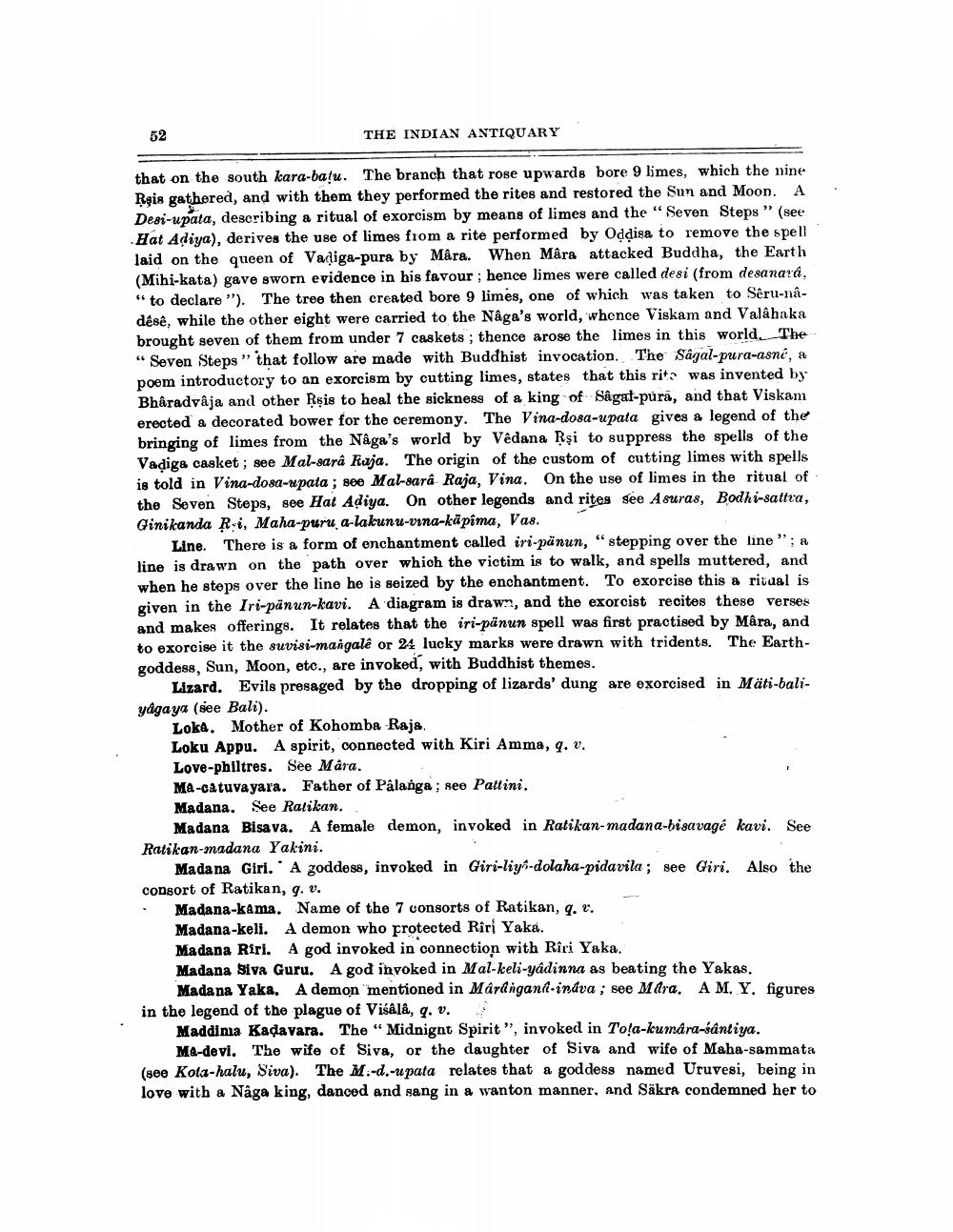________________
52
THE INDIAN ANTIQUARY
that on the south kara-baļu. The branch that rose upwards bore 9 limes, which the nine Rşis gathered, and with them they performed the rites and restored the Sun and Moon. A Desi-upata, describing a ritual of exorcism by means of limes and the "Seven Steps" (see Hat Adiya), derives the use of limes from a rite performed by Oddisa to remove the spell laid on the queen of Vadiga-pura by Mâra. When Mâra attacked Buddha, the Earth (Mihi-kata) gave sworn evidence in his favour; hence limes were called desi (from desanara, " to declare"). The tree then created bore 9 limes, one of which was taken to Séru-nadése, while the other eight were carried to the Någa's world, whence Viskam and Valahaka brought seven of them from under 7 caskets; thence arose the limes in this world. The “ Seven Steps” that follow are made with Buddhist invocation. The Sagal-pura-asné, a poem introductory to an exorcism by cutting limes, states that this rit was invented by Bharadvaja and other Rsis to heal the sickness of a king of Sagal-pura, and that Viskam erected a decorated bower for the ceremony. The Vina-dosa-upata gives a legend of the bringing of limes from the Nâga's world by Vedana Rşi to suppress the spells of the Vadiga casket ; see Mal-sara Raja. The origin of the custom of cutting limes with spells is told in Vina-dosa-upata ; see Mal-sara Raja, Vina. On the use of limes in the ritual of the Seven Steps, see Hat Adiya. On other legends and rites see Asuras, Bodhi-sattra, Ginikanda R-i, Maha-puru a-lakunu-vina-käpima, Vas.
Line. There is a form of onchantment called iri-pänun, "stepping over the line"; a line is drawn on the path over which the victim is to walk, and spells muttered, and when he steps over the line he is seized by the enchantment. To exorcise this a ritual is given in the Iri-pänun-kavi. A diagram is drawn, and the exorcist recites these verses and makes offerings. It relates that the iri-pänun spell was first practised by Mara, and to exorcise it the suvisi-mangalê or 24 lucky marks were drawn with tridents. The Earthgoddess, Sun, Moon, etc., are invoked, with Buddhist themes.
Lizard. Evils presaged by the dropping of lizards' dung are exorcised in Mäti-baliyagaya (see Bali).
Loka. Mother of Kohomba Raja Loku Appu. A spirit, connected with Kiri Amma, q. v. Love-philtres. See Mara. Ma-catuvayara. Father of Palanga ; see Pattini. Madana. See Ralikan.
Madana Bisava. A female demon, invoked in Ratikan-madana-bisavagé kavi. See Ratikan-madana Yakini.
Mada na Giri. A goddess, invoked in Giri-liyi-dolaha-pidavila; see Giri. Also the consort of Ratikan, 9. v.
Madana-kama. Name of the 7 consorts of Ratikan, q. e'. Madana-keli. A demon who protected Riri Yaka. Madana Riri. A god invoked in connection with Riri Yaka. Madana Siva Guru. A god invoked in Mal-keli-yadinna as beating the Yakas.
Madana Yaka. A demon mentioned in Marligand-indva , see Mara. A M. Y. figures in the legend of the plague of VisAlå, q. v.
Maddima Kadavara. The “Midnight Spirit", invoked in Tota-kumdra-santiya.
MA-devi. The wife of Siva, or the daughter of Siva and wife of Maha-sammata (see Kota-halu, Siva). The M.-d.-upata relates that a goddess named Uruvesi, being in love with a Nâga king, danced and sang in a wanton manner, and Säkra condemned her to




